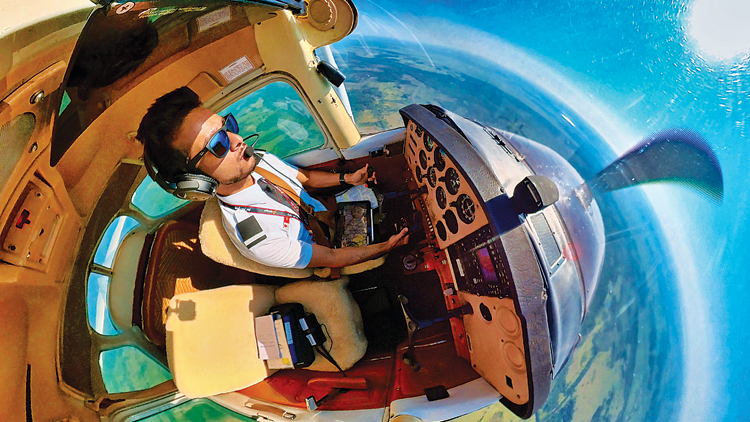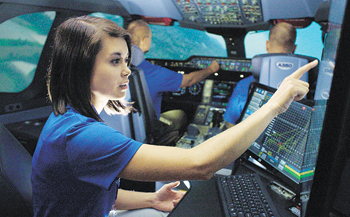Looking at Pilot Hiring Through a New Lens
Hiring strategies in a tight labor market without compromising safety or culture

A tight labor market is forcing aviation managers to look at available pilots through a new lens as they re-evaluate hiring criteria without compromising safety.
The ongoing workforce shortage across business aviation may require flight departments to adapt their traditional hiring criteria for pilots with the demands of an evolving employment landscape, all without compromising safety or company culture. What hasn’t changed are the typical factors pilots look for, including compensation, schedule, job stability and career development opportunities.
“Schedule concerns may often supersede pay with some candidates, particularly for millennials or pilots with families,” said Jeff Poeppelman, chief pilot for NAMC and member of NBAA’s Business Aviation Management Committee (BAMC). “When interviewing candidates, hiring managers must be able to determine if the role aligns with the candidate’s top priorities.”
Longevity also remains a top consideration, and concern, for aviation managers. “Business aviation flight departments once were considered a destination for pilots,” added Greg Burris, director of aviation at Masco. “Now, we’re a waypoint, and I don’t think our industry has adapted to that yet.”
At the same time, flight departments must not go too far in altering longstanding practices and requirements.
“If you change your hiring criteria, you are also changing your safety management system,” said Bill Riter, aviation manager for Rich Products. “You don’t want to adjust down the caliber of pilot candidates you’re looking for. You still want someone who will not only fill the role, but one who will grow with your operation, not only as a pilot or captain, but also as a person.”

“With hiring so difficult right now, more than ever you’re looking for people who will stick around and hopefully not switch jobs frequently,” said Julia Harrington, lead captain and base manager for Axis Jet and co-vice chair of NBAA’s Young Professionals (YoPro) Council. “That comes down to getting a sense of the candidate’s priorities in the interview process.”
Just as flight departments must vet candidates, managers may also increasingly find the candidates vetting them in return. “Smart pilots want an environment where they’ll enjoy working,” she continued. “They want a good sense of the company culture just as much as you’re trying to determine their priorities and if they’d be a good fit with the pilot group. It’s challenging on both sides of the table.”
CULTURE IS KING
Candidates looking for a long-term opportunity with a flight operation will also be looking at how a company’s culture will be consistent with their needs and provide them with opportunities to grow. “Cultural fit of the individual is the biggest determinant of the length of their tenure with your company, their satisfaction with their job and the employer’s satisfaction with them,” said Jim Lara, founder and principal at Gray Stone Advisors.
“With the changing times, newer members of the workforce have different expectations than what we may be used to,” Poeppelman added. “It’s extremely important to find out what’s most important to the candidate and what your organisation might be able to offer them.”
Quality of life may take precedence for these younger workers over other considerations, including pay. That can be a double-edged sword for flight departments that are already short-staffed.
“Employers must have sufficient staffing to allow quality of life to happen,” Lara said. “Otherwise, no matter what your intent is, you’re going to overwork people. We’ve found that 15 duty days a month is a realistic expectation; push that to 17-19 days and you will wear people out.”
While flight departments may have an urgent need for new pilots, Harrington cautioned against rushing through the hiring process.
“A one-and-done interview isn’t incredibly helpful in this environment,” she said. “A multi-stage process – a phone interview, followed by an in-person meeting and maybe even a social gathering with other pilots over dinner – is far more beneficial. If you try rushing things, you might hire someone who’s just looking for a type rating before moving on.”
“We get everyone involved in our hiring process – line service, maintenance technicians, schedulers and others,” Riter said. “Having multiple perspectives can make the difference in identifying a good fit for your flight operation. If one person has that gut feeling, it means we need to dig a little deeper. It’s not a foolproof process, but it has worked really well for us.”
Increasingly, pilot candidates also expect to have set, or “hard” days off. “That means that you’re really off,” Lara emphasised. “Now, the random nature of business aviation can make that difficult, but we’ve started with three hard days off per month and as close to a month’s advance notice as possible so pilots can plan ahead. Most flight departments can make that work.”


NEW APPROACHES AND NEW CONSIDERATIONS
With business aviation flight departments eager to find new talent, and potential hires often having their pick of job opportunities, “the script has flipped a bit,” said Poeppelman. “You really do need to sell yourself as an employer. Your reputation matters, and once that changes it’s very difficult to get it back.
“That said,” he continued, “there are still a lot of great organisations that are extremely selective and offering wonderful career opportunities for the right candidates.”
With hiring shortages expected to continue, flight departments may also need to be more active in finding those candidates. “You cannot wait for folks to apply,” Lara said. “You must leverage your circle of friends and your network and find [pilot candidates]. It’s a search and it’s a struggle, but it’s necessary.”
Burris recommended reaching out to local schools and universities, not only to identify potential candidates but also to raise awareness of the industry. “We work with a local high school aviation group,” he said. “None of the students knew about business aviation when we brought them to our hangar the first time. That told me there’s more we should be doing to educate people about opportunities in our industry.
“It’s tough to battle airlines when it comes to marketing ourselves, especially given the financial incentives being offered right now,” he continued. “There will always be those individuals who want something a little different, though. Not better or worse, just different. And business aviation is a great destination for those pilots.”
Aviation managers may also look to candidates with lower flying time, or those needing to be typed on their fleet of aircraft. “Flight departments have been forced to become nimbler and more flexible,” Harrington said. “You should be willing to wait those extra months it may take to bring the best pilot up to speed with your operation, or while they’re waiting on a training slot.”
“We have changed our lens, so to speak,” Burris agreed. “We look at the complete pilot rather than the logbook. There are some incredible individuals with very low time who may be the perfect fit for the right flight department, but there’s also a lot that goes into making that happen.”
Riter recommended flight departments also consider their relationship with their training providers. “I must tip my hat to my training officer and chief pilot, who around four years ago made it a priority to build a professional relationship with our two providers,” he said. “We may not get the exact slots we want, but we’re not waiting for months at a time, either.
“It’s clear when it comes to hiring, that we are not out of the woods by any stretch of the imagination,” he concluded. “But that doesn’t mean we should just hire somebody to fill a void or seat. That could ultimately destroy a flight department’s safety culture.”





